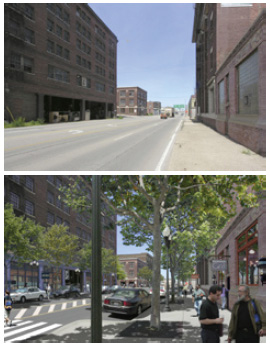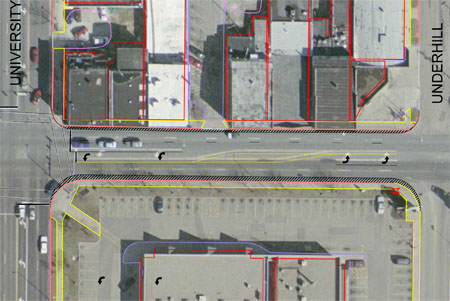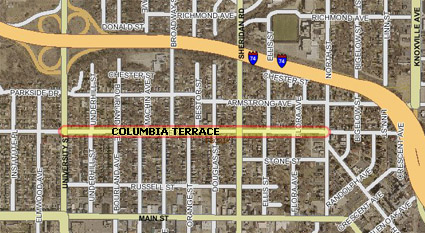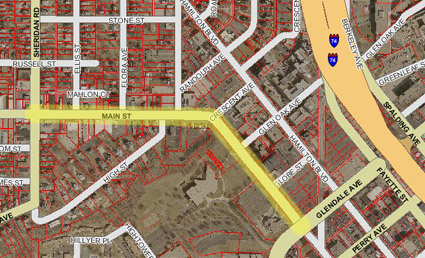 U.S. Route 24 and Illinois Route 29 run through the Warehouse District in downtown Peoria, and that’s causing a problem for the City. The City wants to make Washington Street more pedestrian friendly by narrowing it and adding on-street parking on both sides of the road. Property owners in that area say they need a more pedestrian-friendly Washington Street in order to successfully redevelop those old warehouses into loft apartments, condos, retail shops, and restaurants. Because of the road’s designation as Routes 24 and 29, any changes to the street must be approved by the Illinois Department of Transportation, and they don’t want parking on both sides of the street. In fact, they prefer it wide and fast, just like it is now.
U.S. Route 24 and Illinois Route 29 run through the Warehouse District in downtown Peoria, and that’s causing a problem for the City. The City wants to make Washington Street more pedestrian friendly by narrowing it and adding on-street parking on both sides of the road. Property owners in that area say they need a more pedestrian-friendly Washington Street in order to successfully redevelop those old warehouses into loft apartments, condos, retail shops, and restaurants. Because of the road’s designation as Routes 24 and 29, any changes to the street must be approved by the Illinois Department of Transportation, and they don’t want parking on both sides of the street. In fact, they prefer it wide and fast, just like it is now.
That leaves only one option if the City is going to move forward on its preferred Washington Street makeover: move the route designations and take over jurisdiction of the street from the State. Under a proposal that comes before the Council next Tuesday night, routes 24 and 29 would be rerouted to East Peoria, bypassing downtown Peoria. Specifically, Route 24 traveling northeast would cross the river on the Shade-Lohmann (I-474) bridge instead of the McClugage, effectively bypassing Peoria altogether. Route 29 traveling southeast would cross the river on the Murray Baker (I-74) bridge instead of the Cedar Street bridge, bypassing downtown.
Those changes come with a cost. Because of the route designations, Peoria receives $45,000 each year from the state to help with maintaining those streets. In addition, the State does all the resurfacing work at its own expense — for the work they’re doing this fall, that comes to about $5.44 million. Including routine maintenance and periodic resurfacing, the Public Works Department estimates that it will cost the City an average of $563,669 per year over the next 20 years to take over maintenance of the street.
There had been talk in the past of moving 24 off of Washington Street, but keeping it on this side of the river — perhaps moving it to Adams and Jefferson. However, even if IDOT would agree to it, it would only be a temporary fix, as the City would inevitably run into problems changing those streets in the future. Caterpillar has also made it clear that it does not want the route moved to Adams street, which passes by the front door of their world headquarters.
It is unfortunate that IDOT is being so inflexible on this issue. Since 2003, they are supposed to have been embracing “context sensitive solutions,” “an approach that uses many tools with one goal in mind: plan and design transportation projects that ‘fit’ into their surroundings – what is known as ‘context.’ It involves: Striking a balance between safety, mobility, community needs, and the environment . . . Addressing all modes of transportation in the planing and design of the project, including motor vehicle, mass transit, pedestrians and bicyclists . . . Applying the flexibility inherent in our design standards to fit the project into its surroundings . . . [and] Incorporating aesthetics as part of basic good design.”
A portion of Illinois Route 83 travels right through downtown Antioch, Illinois. This section of state highway carries an average of 12,300 vehicles every day — slightly more than the 11,600 that Washington St. carries through the Warehouse District — yet, take a look at IDOT’s Illinois Route 83 Project page:
…the downtown segment typical section will have one 11-foot through lane in each direction separated by an 11-foot striped median with 8 foot wide parking stalls. The Village of Antioch was involved in the development of geometry of the “downtown” section.
Now, why is it okay to have three lanes of traffic and parking on both sides of the street on Route 83, but we can’t have the same thing on Route 24? Why the inconsistency?
I’ve asked that question in the past and been given two answers. One is that on-street parking has been “grandfathered in” on state routes in some communities; so, if you already have parking, you get to keep it, but you can’t add it if you don’t already have it. This only goes to show that the no-parking requirement is arbitrary and baseless. If it were a vital safety issue, there would be no “grandfathering in” since it costs nothing to remove parking from a route. The other reason I’ve been given is that IDOT divides Illinois into different regions, and each region has its own engineer who sets the rules for his or her area. We’re in Region 3 and Antioch is in Region 1. Thus, the Region 1 engineer allows parking, but the Region 3 engineer, Joe Crowe, does not. In other words, there’s no consistent policy for the State.
No matter how you look at it, the State of Illinois is bent on frustrating Peoria’s plans to improve its downtown, and the only option left is for Peoria to give up the route designations and pay for the street maintenance itself. But can Peoria afford it? The City is already looking down the barrel of a $10 million deficit for next year. More drastic cuts to basic services are being contemplated. Will development of the Warehouse District produce enough new revenue to make losing the route designations worth it?
There haven’t been any studies (that I know of) yet, but consider that the City figured two hotels and three restaurants on one block (the Wonderful Development) would raise enough revenue to cover $37 million in debt service over twenty years. Surely a mixed-use residential/retail development in the Warehouse District with multiple developers over ten blocks will raise enough revenue in property and sales tax increments to cover $8.3 million (in today’s dollars) over the next 20 years, especially since there would be no bond issue and thus no debt service costs. Still, it wouldn’t hurt to get a commitment from the Warehouse District developers before moving forward.



 On Tuesday night’s City Council agenda is a grant application to the Federal Highway Administration’s “Highway Safety Improvement Program” to improve Main Street from Sheridan Road to Glendale Avenue (see map to the right). This corridor would be eligible for funding because it is a “high accident location” and because it has a “high cost benefit ratio,” according to the
On Tuesday night’s City Council agenda is a grant application to the Federal Highway Administration’s “Highway Safety Improvement Program” to improve Main Street from Sheridan Road to Glendale Avenue (see map to the right). This corridor would be eligible for funding because it is a “high accident location” and because it has a “high cost benefit ratio,” according to the